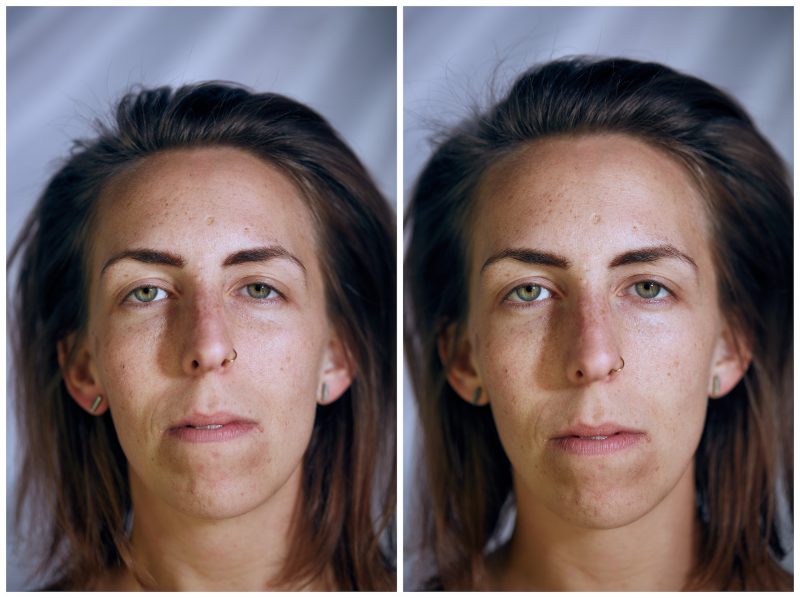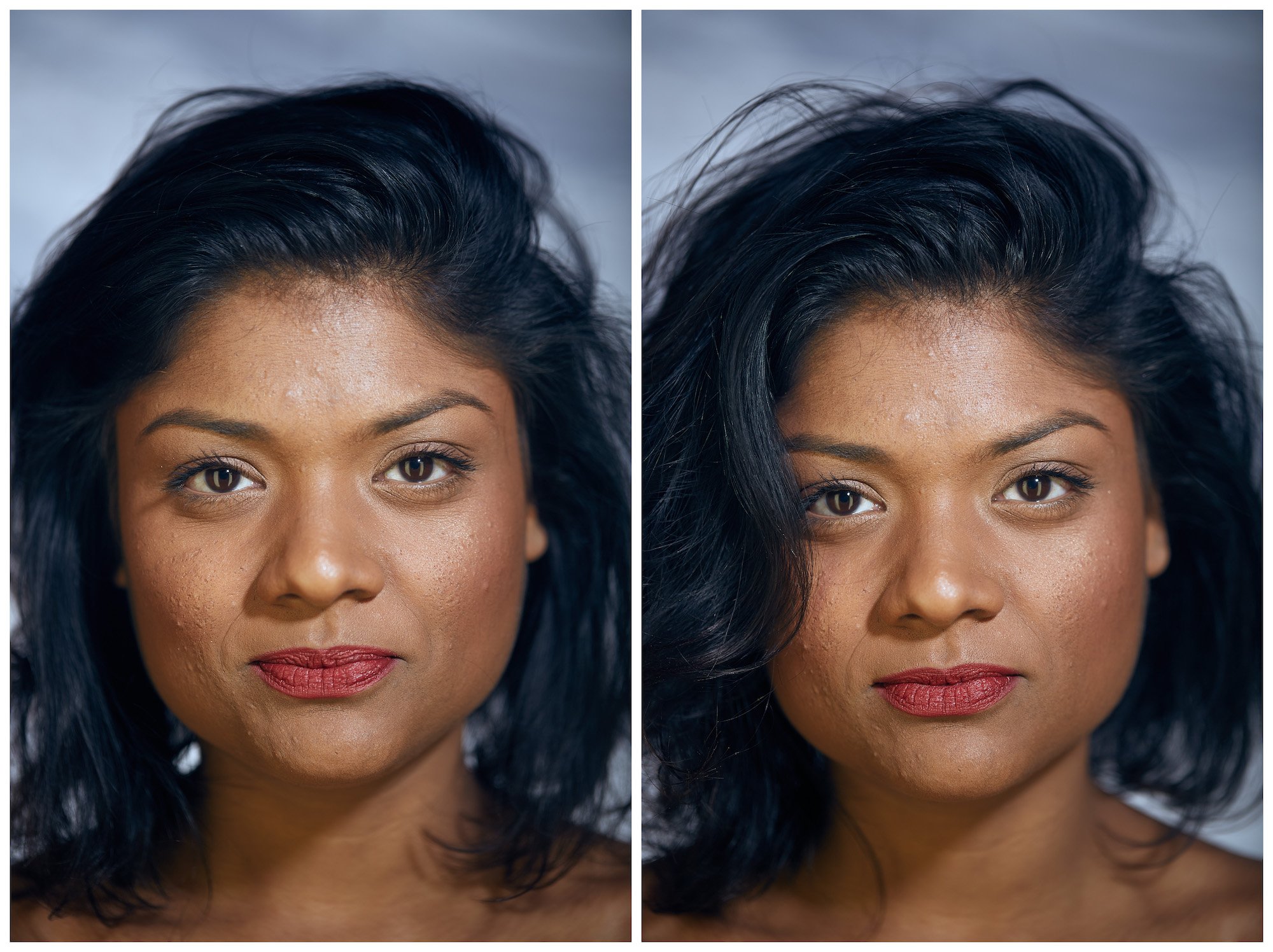- “Naked Faces” is a photo series created by Canada-based photographer Dylan Hamm.
- The series includes side-by-side images of 43 people, and captures their facial expressions before and after they removed their clothing.
- The photos are not displayed in any particular order, and Hamm has not yet revealed which photos were taken with clothing, and which ones were taken without.
- Speaking to INSIDER, Hamm said he wants people to walk away from the series with a sense of “how nonverbal communication is a real and important thing.”
- Visit INSIDER’s homepage for more.
Nude photography is often considered to be risqué, but Canada-based photographer Dylan Hamm wants to challenge the way people see nudity with a revealing photo series that takes a unique approach to the topic.
Hamm’s series “Naked Faces,” which he started in 2016, is comprised of side-by-side images of 43 people, all of whom were photographed while wearing clothing and while naked. But, rather than photographing their full bodies, Hamm focused on the subjects’ faces so the viewer can analyze how a person’s facial expression differs while they are clothed and unclothed.
After completing the series, Hamm mixed the photos around, and has yet to reveal when each photo was taken.
INSIDER spoke with the photographer to learn more about his series, which you can see below.
"Naked Faces" is a photo series created by photographer Dylan Hamm.

Hamm is based in Vancouver, British Columbia, and works as a professional photographer. He graduated from Sheridan College's Applied Photography Diploma program.
The series includes photographs of 43 different subjects.

Both men and women are included in the series, as well as people of varying ages.
Each subject was photographed twice for the series — once while clothed, and again while nude.

The photos were then arranged in a side-by-side format for viewers to easily compare the two images.
The series aims to explore nonverbal communication, specifically that which is unintentional.

Nonverbal communication, also known as body language, is a facet of our daily lives - we hug, cross our arms, and roll our eyes, among other examples. But we typically do so intentionally.
While creating his series, Hamm "set out to prove the notion that people show more on their face than they are aware," according to his website.
There's no actual nudity shown throughout the "Naked Faces" series.

On his website, Hamm says he "put out a call for people willing to be photographed naked" in 2016, but assured that "no nudity would be captured or released."
To do so, he only photographed subjects from upwards of their shoulders.

Each photo from the series shows a subject's face, neck, and the top of their shoulders.
Only Hamm and his participants know which photos were taken while clothed, and which ones were taken while nude.

While Hamm has shared all 43 images on his website, he has yet to reveal which photos show clothed subjects, and which were taken while they were naked.
In most cases, the two photos look nearly identical.

These two photos of a male participant, for example, are nearly indistinguishable from one another.
But in others, clear differences are visible.

This participant appears to have been smiling more on the left, and posed with a more stoic expression on the right.
The placement of his hair is also different between the two photos.
Other participants made distinct facial expressions in each photo.

In the photo on the left, this subject looked straight into the camera and appeared calm.
However, he seems to have been startled in the second image, and had much wider eyes.
Smirks are a telltale sign that something has changed.

This participant is one of many who looked cool and collected in one photo, but expressed a slight smirk in the other.
Some photos, like these ones, appear to have been taken from different distances.

The photo on the left is more zoomed out, and captures the subject's face, neck, and some of their shoulders. But on the right, only his face and neck are visible.
This set of photos also shows a drastic difference in distance.

The subject is close to the camera in the first photo, and farther away in the second. However, her facial expression looks nearly identical in both images.
Hairstyles also vary between each photo in the series.

This participant, for example, appears to have ruffled bangs in the first photo, and a sleeker style in the second.
Some people tilted their heads differently in each photo.

While this subject had his head titled to the side in one photo, he looked straightforward at the camera when posing for another.
His facial expression also differed between the two photos.
Speaking to INSIDER, Hamm said he began to question "subconscious communication" in 2016.

"I had been thinking up the concept for a while. Moreso, the differences people can make with their faces without meaning to: subconscious communication," Hamm told INSIDER.
Hamm spent a lot of time thinking about his idea before following through on the project.

Specifically, Hamm looked to "professors and friends" to help flesh out his idea.
And he didn't stop there.

The photographer also spent "a lot of time journaling and researching" before shooting any images.
Initially, Hamm faced difficulty when looking for photography subjects.

According to Hamm, finding people to participate was a "challenging task" - especially because he hadn't yet photographed any images for the series, and couldn't share a visual example of his concept.
People were mostly afraid of being photographed without clothes on.

"I had a lot of people turn the idea down, simply not wanting to be photographed naked" Hamm said.
In order to get people onboard with his project, Hamm decided to "split the [photo shoot] into two days."

While Hamm took photos of "the same person clothed and naked on the same day, within a two to three minute window," he didn't photograph all 43 subjects in one day.
Instead, he photographed a smaller number of people, and then showed their photos to new subjects in attempts to "entice people to come to the second photo shoot."
The two-day photo shoot helped participants feel comfortable while being photographed.

According to Hamm, he split the photoshoot into two days "knowing that people would change their mind once they understood the concept visually."
Hamm also said participants were especially reassured when they arrived at the venue and saw that he "wasn't actually taking a photo of them below their collar bones."
The photographer was already familiar with many of his subjects before conducting the photo shoot.

According to Hamm, "most of the [subjects] were friends, and friends of friends."
Due to the nature of the photo shoot, Hamm made sure his shooting location was as private as possible.

Specifically, clothed and nude subjects posed in a closed-off area that was covered by curtains.
When not being photographed, participants were allowed to hang out in a separate part of the venue.

According to the photographer, there was "an open area for those who came early, or in groups, with some snacks and beers."
While sitting in the photography booth, Hamm overheard some of his subjects discussing the project.

"There were a lot of different ideas being talked about: how nervous [subjects] were, how confident people were," Hamm said.
Read more: 33 viral pictures that captured hilarious coincidences in real life
While participants may have entered the photo shoot with one mindset, many of them left with another.

"A lot of mindsets changed once they entered the [photography] space," Hamm said. "Proud men felt nervous, and nervous women felt empowered."
Those flipped expectations were most visible during the nude photoshoot.

On his website, Hamm said "the approach and reaction to the act of getting naked varied from laughing, to yelling, and making jokes."
However, the photographer also said those reactions "rarely linked to the results captured."
Hamm found that his project challenged gender stereotypes,

On his website, Hamm said the series has "raised questions about gender stereotypes, the subconscious, the way we change imperceptibly to ourselves, and perceptibly to others."
Specifically, Hamm assumed women would be shy, while men would be outgoing.

"I had in my mind that women would be more self-conscious than men, and men would have their chests puffed out," Hamm said. "But the script was flipped pretty quickly."
Speaking to INSIDER, Hamm said the mixed reactions of participants helped to further prove his initial hypothesis.

"It really helped shape the concept that everyone could talk one way, but their body language and micro-expressions told me the real story," Hamm said.
These reactions are also part of the reason as to why Hamm decided to jumble the images after the photo shoot.

While Hamm could easily share his exact findings, the photographer instead chose to mix up the order of his images "so that the photos become more of a conversation" among viewers.
Of course, some people have correctly guessed when each photograph was taken.

"I have had people email me with their findings, and I give them how many they got correct, but I'm yet to want to share the answers," Hamm said.
Hamm told INSIDER that "some photos are easier to identify than others."

But to really figure it out, you might want to consider working with a group.
"By large, especially if people are looking with others and talking it out, they are able to generally find an answer they are happy with," Hamm said.
But the photographer doesn't want his series to turn into a guessing game.

"I prefer to have people come to conclusions by means of interaction, and leave feeling curious about themselves, and what they share without knowing," Hamm said.
Personally, Hamm feels the results of his project are “astounding.”

On his website, Hamm said the different reactions he captured were sometimes "subtle, contrasting, and ridiculous."
The photographer also believes his series created more questions than it answered.

"As an artist, this series isn't one that is culminated with the answering of the question asked," Hamm said on his website. "Rather, it has become an investigation that is ongoing."
However, Hamm has faced one criticism in response to "Naked Faces."

"Some of the criticism I have given myself, plus received from others, is that I should have a more diverse group of people [in the series]," Hamm said.
Creating "Naked Faces" also led Hamm to another important realization.

"[Creating the series] really helped me see that everyone deals with body image to some capacity, no matter their gender or age," Hamm said.
Now, Hamm is looking to "orchestrate a few more chapters" of the "Naked Faces" series.

"While it was difficult on the first round to gather a wide range of faces, my plan is to take this series to a new country," Hamm said.
While there, the photographer hopes to "make a few pit stops to gather more faces from around the world" and "understand the mind on a larger scale."
And unlike the first installment of the series, Hamm would like to photograph complete strangers.

"Ideally, I can move more into the general public now that I have some validation to the concept," Hamm told INSIDER.
Overall, Hamm hopes that viewers are able to focus more on the concept of his series "moreso than the actual photos."

"I hope that people share my work and take the conversation further and further," Hamm said.
The photographer also hopes to create more conversation surrounding nonverbal communication.

After people see his photos, Hamm hopes viewers will want to "spread meaningful conversations about the inner workings of the brain, and how nonverbal communication is a real and important thing."
- Read more:
- An artist edits herself into iconic photos of celebrities that make it seem like she can travel through time
- An artist turns Picasso paintings into optical illusions that look like photos of real objects
- 51 disappointing photos that show what famous art is really like
- 61 of the best wedding photos taken in 2018

